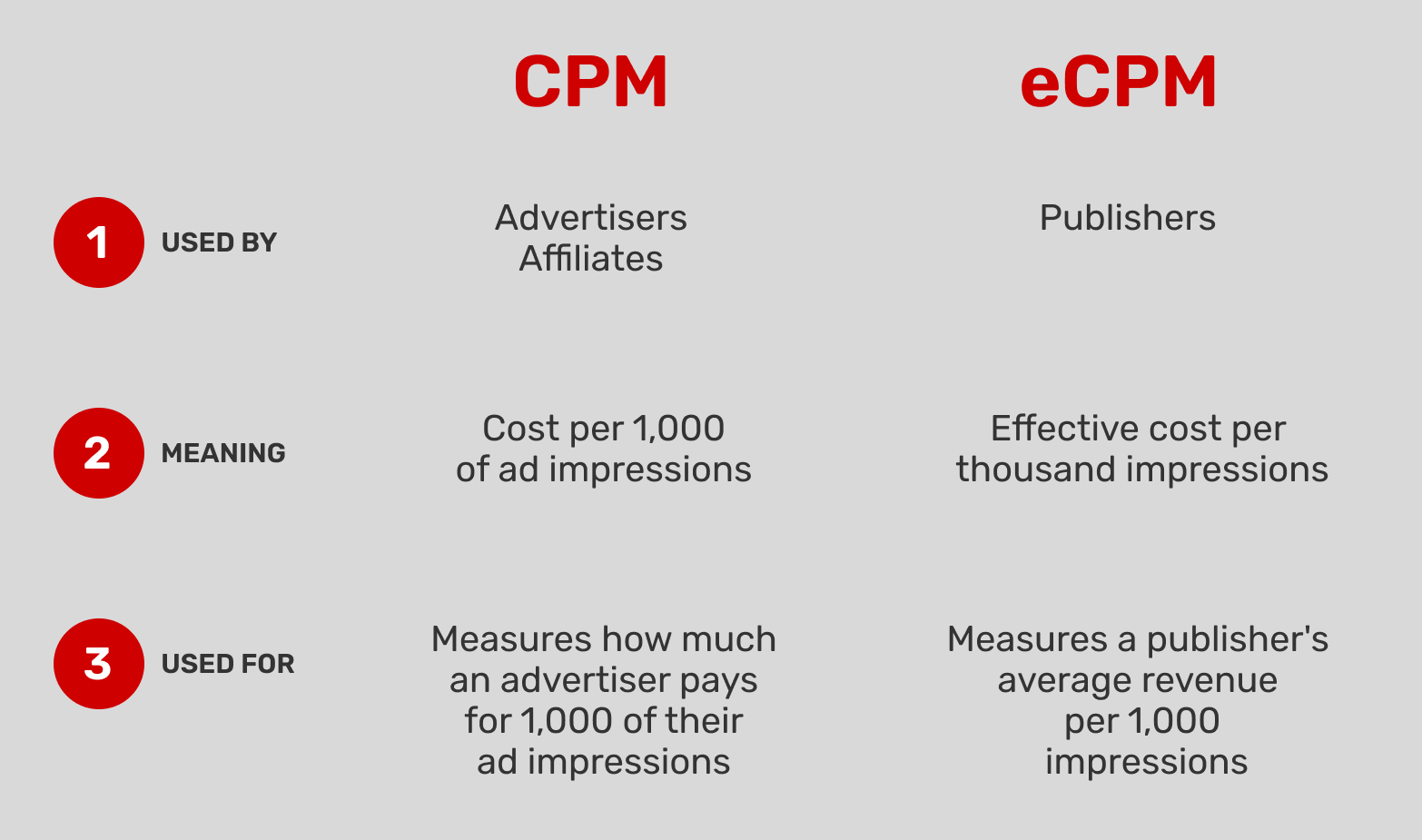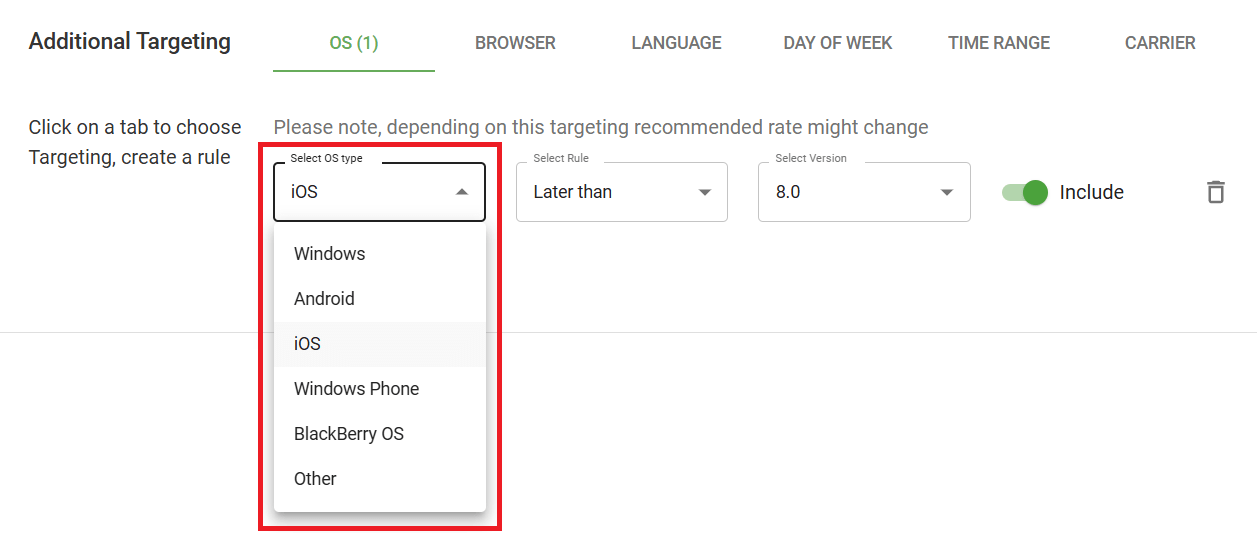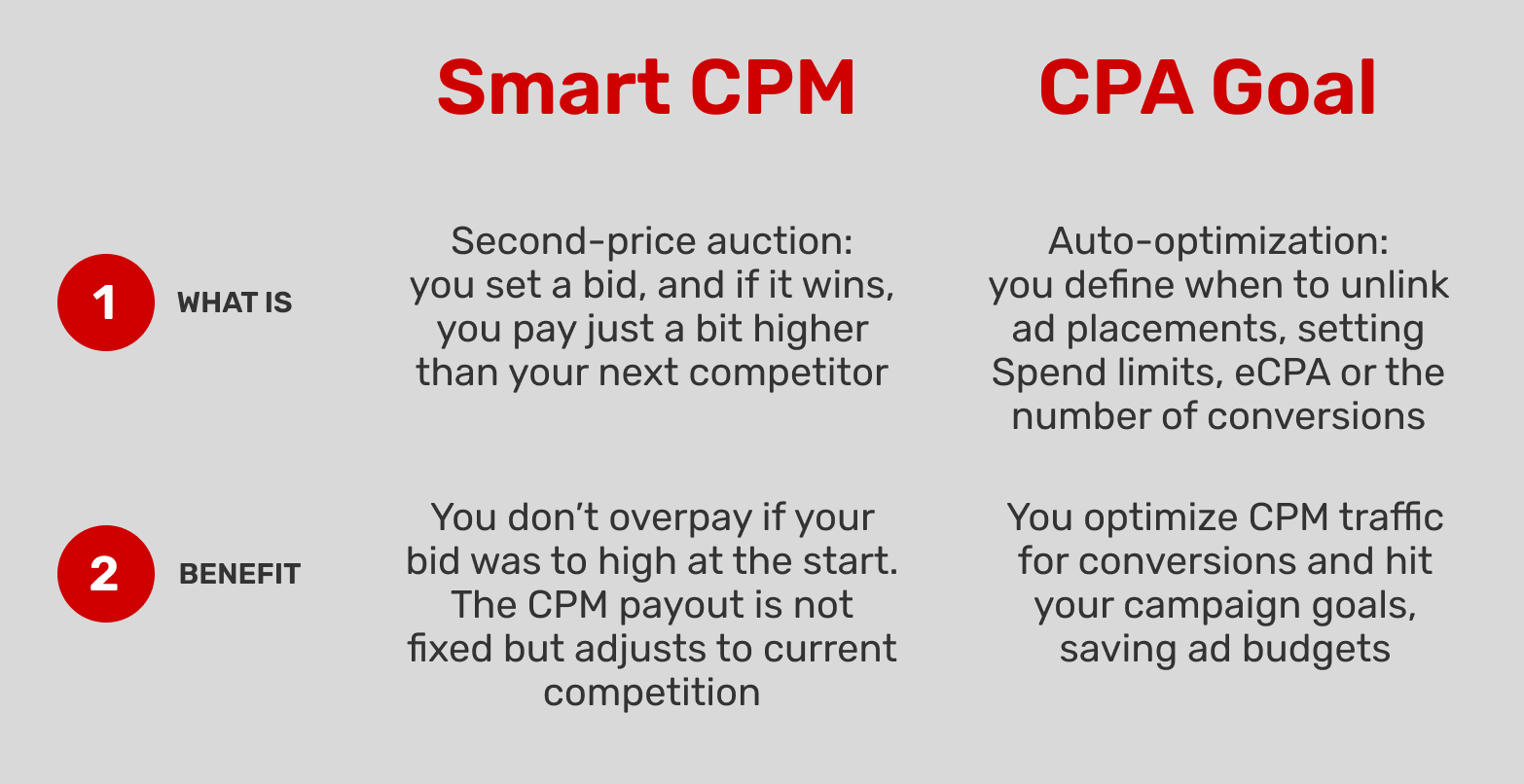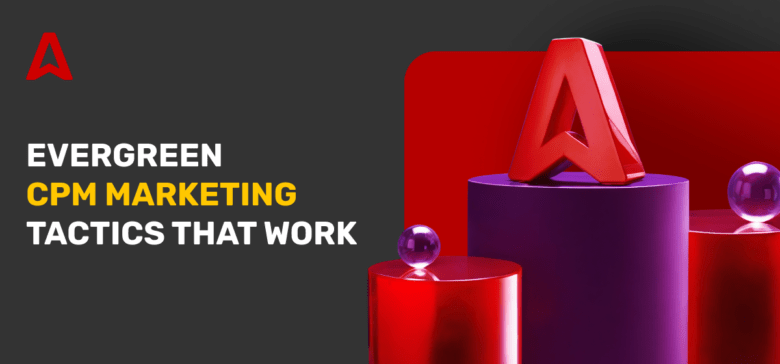CPM is a pricing model that equals to the cost of 1,000 ad impressions on a publisher’s platform. CPM rates include the number of impressions sent and the associated costs, which helps advertisers compete for better placements while publishers balance profits. This article explains the CPM meaning, how it works, calculations, and beneficial use cases you can apply in your marketing.
What does CPM stand for?
The cost per mille CPM (also: cost per thousand impressions) shows how much an advertiser pays for every thousand times an ad appears to users. In digital marketing, the Cost Per Mille is one of the common methods of pricing.
In digital advertising, an impression occurs when a user views an advertisement. The ad element must be visible for a certain duration, so we only observe viewable impressions as a key metric. Unlike CPC models, which count clicks and click-through rates, CPM pricing only charges you per 1,000 ad views.
CPM strategies help increase brand awareness, generate leads, test new traffic sources, or refer massive visits to your offer.
For publishers, CPM stands for “earnings per thousand impressions,” which is an evergreen metric to count gains from ads.
Click-through rates vs cost per thousand impressions
The click-through rate (CTR) is usually included in CPM marketing. You calculate CTR by taking the number of clicks and dividing by the number of impressions. Though CTRs are different metrics, they’re important to measure ad engagement and marketing campaigns’ efficiency.
How to calculate CPM? CPM formula with calculations
The cost per mille CPM has two components: the total number of impressions and the total campaign cost. You divide the total cost by the number of impressions and multiply by one thousand. For example, with a cost $500, you have received 100,000 impressions. The CPM will equal $5.
Cost per mille formula: CPM = Total Cost / Total Impressions x 1,000

eCPM vs CPM
The pricing structure for publishers usually relies on eCPM rates (or, effective earnings per thousand impressions). They divide their total earnings to the total number of advertising impressions and then multiply that by 1,000.

The highest-paying CPM networks also include clicks and conversions in eCPM, because such user actions are more expensive compared to simple impressions. Companies pay highly for signups, sales, orders, and other actions. Here’s how publishers can grow revenues faster.

Other metrics like CTR are also important for evaluating how many clicks an advertisement receives relative to its impressions. If the user engages with ads, publishers get paid more.
CPM metrics vary from platform to platform. Google Ads count vCPM (viewable CPM) that ensures you are charged only when advertisements are seen. Adsterra counts only fully loaded advertisements, protecting you from overpaying. Video platforms also take into account the percentage of video ads viewed.
What can affect CPM?
Several factors affect CPM rates. The amount of money spent on advertising via cost per mille depends on:
- country (or geo)
- traffic type (desktop vs mobile; Android vs iOS, etc.)
- traffic quality
- competition for traffic*
- seasonality
- niche (or vertical).
Competition for advertising inventory—the available ad spaces on websites and platforms—can significantly impact CPM rates. The screenshot below showcases how smart algorithms estimate the cost-per-thousand rate on Adsterra. The Traffic Estimator evaluates competitors’ bids and helps start with a winning CPM strategy.

CPM vs. CPC and CPA in advertising
Marketers switch between pricing types to hit campaign goals. The CPC (cost per click) pricing method is very common in digital advertising, especially on Google Ads (it’s called PPC, or pay-per-click). Advertisers pay only when their ad is clicked. The CPA (cost-per-action) model involves payment for target actions only. Depending on the advertising niche and conversion flow, each paid pricing model can maximize ROI. Let’s now compare the most popular pricing models:
| Model | Objectives | How it works | Use case | Example |
|---|---|---|---|---|
| CPM | Increase reach, get more traffic, test complex conversions (deposits) | Pay for the number of impressions (1,000 views) | Launch new products, raise brand awareness, test iGaming or E-commerce campaigns | With $10,000 and a CPM of $10, a campaign can generate 1,000,000 impressions, increasing brand visibility |
| CPC | Prequalify traffic, weeding out “watchers” | Pay only for the clicks received (pay per click) | Attract visitors to the website, generate leads, or promote specific offers | With $5,000 and a CPC of $2, you can get 2,500 visits if all users click the ad |
| CPA | Focus on sales or other conversions | Pay only when a desired action is performed | Achieve sales, sign-ups, or subscriptions; maximize ROI for campaigns focused on concrete results | With a CPA of $50, a $10,000 budget can deliver 200 actions maximum (a fantastic 100% conversion rate) |
Monitoring CPM campaigns’ ROI in audio and video channels also includes measuring the effective cost per audio complete (eCPAC) and CPCV (cost per completed view).
Benefits of CPM for advertisers
1. Cost-efficiency
The CPM pricing is a cost-effective way to run iGaming campaigns with complex conversions like FTDs (first-time deposits). Many iGaming and E-commerce campaigns run on a CPM logic, which allows marketers to control costs while maximizing exposure.
Advertisers can acquire much more traffic at lower costs. With refined targeting, this tactic is safer in terms of spending:
- Select the desired targeting options
- Pick a competitive bid
- Run a test
- Optimize targeting and bids
- Launch the campaign again
- Form whitelists and experiment further with bids and creatives.
Though you don’t focus on conversions, you reach out to relevant audiences who will convert and return you profits, thus enhancing your credibility.
2. Rich targeting options
Just like with other pricing types, advertisers can target by country, city, operating system (OS), browser, and language. For example, you can exclude users with older OS versions and focus on those who are more likely to convert.
Platforms like the Google Display Network and Adsterra offer advanced targeting options for CPM campaigns, allowing advertisers to efficiently reach specific audiences.

We connect companies and products with high-intent audiences from 248 geos, serving 1.6 billion conversions per year. It’s about time to add premium traffic sources to your arsenal.
3. Budget planning
A well-planned CPM campaign ensures predictability and efficiency, allowing you to watch your ad spend closely. The CPM model allows you to pay a concrete amount for every 1,000 impressions. It’s easy to control budgets and achieve the desired reach. To ensure success, you need to:
- Define objectives
- Select the target audience
- Set a competitive bid
- Upload engaging ad creatives
- Calculate a budget
- Define budget limits
- Launch a test.
A successful example of acquiring CPM iGaming traffic is a campaign in Thailand that utilized the Social Bar ad format. With a $1,230 investment, our partner generated $4,005 in profit.
4. Measuring ROI
Measuring ROI in CPM campaigns is as transparent as with any other pricing model. It’s essential to analyze the full picture of campaign data, including impressions, conversions, and revenue. Conversion trackers are a must in this case.
A case study by a pro affiliate showcases ROI measurement. He used Interstitial ads to promote an iGaming app in the Philippines. With total spending of $1,412 and earnings of $3,334, he achieved an ROI of 236.12%. The campaign was regularly optimized to generate revenue.
5. Cost optimization algorithms
The CPM model is perfect for companies looking to reach a large audience without spending too much. However, you can hardly find a marketer who doesn’t want to reduce costs further at every step.
Algorithms like Smart CPM allow for optimizing spending. CPA Goal auto-optimization is a strategy that enables you to set rules and unlink placements if they don’t meet vital KPIs: eCPA or the number of conversions.

What are the best practices in CPM advertising?
CPM advertising best practices include choosing the right traffic source, running a test campaign, optimizing traffic and ad placements after the test, and narrowing down targeting or scaling. For example, for iGaming promos, Adsterra is a top-choice traffic source where you can both target widely or include advanced audience segmentation. Additionally, the platform effectively combats advertising fraud and bot traffic, verifying the authenticity of impressions sent.
Cost per thousand in digital advertising: Bottom line
CPM is the most common pricing method to charge you for website or social ad views. Use it for lead generation, driving sales and deposits, especially when you enter a new market.
CPM is a common way to maximize digital marketing efforts that is used on display ad platforms like Adsterra, campaigns on search engines, and email marketing platforms.
The cost-per-mille advertising is cheaper than cost per acquisition (CPA) or cost per click (CPC) promotions. However, it’s less predictable at the same time. That’s why we recommend using trackers and using Adsterra’s CPA Goal automation to ensure you only spend on target actions. Want to check this combo now?
CPM in online advertising FAQs:
What is CPM definiton?
CPM refers to one thousand ad impressions advertisers pay to appear on a publisher’s website. It’s a pricing model or pricing method to charge media buyers and the way to pay publishers for their traffic. The CPM model is also called “cost per mille,” which means the cost of a thousand ad impressions.
How to improve CPM ROI?
To maximize advertising efforts and ROI, use targeting filters (country, city, OS, browser), balance views’ frequency, and customize bids for specific placements. Use conversion trackers to get clear info about target actions, or turn on the CPA Goal feature to optimize traffic for conversions.
Is CPM still popular in online advertising?
Yes, CPM is widely used in display and programmatic advertising. It allows you to show ads to specific audiences (targeting settings) and track results, controlling total ad spend. Advertisers hit their business goals of growing brand awareness, generating signups, and increasing sales. Publishers manage the revenue generated by regularly checking how costs per 1K of impressions change.
Which CPM is better, high or low?
For marketers, low CPMs are considered to be better as they allow to buying cost-effective traffic. However, cheap traffic usually converts worse. For publishers, “low CPM rates” is a trouble as their revenues are tied to this metric. A balanced cost per mille is the best option as it marks high-quality traffic, higher payouts, and a better ROI.
CPM meaning in digital marketing
The Cost Per Mille concept in digital marketing defines how much an advertiser pays for every thousand impressions their ad receives. As a pricing model, CPM is widely used in online advertising campaigns, from display ads and video ads to social media and programmatic advertising.
What is CPM used for?
CPM allows businesses to maximize the reach of their marketing campaigns and efficiently spend their advertising budget. It’s one of the essential strategies for maximizing advertising efforts and achieving business goals with lower costs if compared to CPA pricing.
How to plan CPM campaigns?
CPM campaigns start with goals: increase brand awareness, boost traffic, or test a specific message. Next, define how to measure these goals. Identify target audiences and select ad formats and ad placements. Most common formats are: Pop-ups, Push Ads, Video Ads, and Native Banners. Check current rates on your platform. Ensure you have enough money for tests and start a test.
What does $20 CPM mean?
With a $20 CPM, advertisers pay $20 for every thousand impressions of their ads on a publisher’s traffic source.
Is $5 CPM good?
The $5 rate is good if you buy traffic in highly competitive countries or if you drive massive daily impressions as a publisher. For example, with one million viewable impressions and the payout of $5 for each thousand, you would get $5,000 daily earnings. But CPM rates don’t normally stay as fixed as in the example given.
